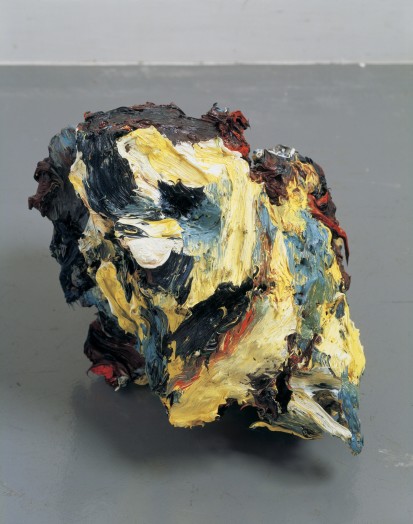Jekyll Island: Honor Fraser Gallery, Los Angeles
Honor Fraser gallery presents it's annual summer group show titled "Jekyll Island", co-curated by independent curator/art critic Max Henry and artist Erik Parker.
The social fabric of the day is one where fiction is reality and reality is an illusion; a post-cultural dystopia surrounds us, history is revised as it occurs. In an all-media upload/download world contemporary art absorbs and distills the information flux; truer narratives emerge. As an international cross-section Jekyll Island is the good, the bad, and the ugly found in this collective psyche. An analogue residue pervades, as the last dregs of the plastic arts and its overlapping references fight for positioning against the grain of the virtual artifice.
Idiosyncratic, edgy, and downright dirty Jekyll Island is a descent from the sublime to the ridiculous. Turning modest materials into crude forms a black humor can be discerned in the works of Lizzi Bougatsos, Daphne Fitzpatrick, Jóhannes Atli Hinriksson and Joep van Liefland. All four play on the idea of reusing and recycling lowbrow materials into new means of communication. Nordic mythology and an outsider's unconventionality underscore Hinriksson. Fitzpatrick and Bougatsos mine the wreckage of industrial detritus while van Liefland journeys into the fractured psyche of the modern man and technological obsolescence.
Polemical misanthropy can be had in Justin Lieberman's mixed media sculptures with their dialectical push pull. Steve DiBenedetto, Glenn Brown, Bjarne Melgaard, Jin Meyerson, Phoebe Unwin, Ged Quinn, and Peter Saul are distinguished by singular styles of painting.
At 74 years of age Saul continues his trenchant observations of the pervading social political atmosphere through vivid Pop inflected imagery. Brown's bastardized classicism, virtuoso brushwork, and potent color contrasts remix Old Master techniques with reproductions culled from popular culture. Bombastic and self-confessional Melgaard is pure expressionism and absolute rage. Meyerson and DiBenedetto posit the post-nuclear global village as an architectural refractory of urban chaos. Söderberg hijacks the icons of new age spiritualism to make pseudo-mystical composites. Unwin's unorthodox palette, receding objects, disembodied portraiture, and figuration are suspended in limbo hovering somewhere between the virtual and the physical.
Ged Quinn's sublime pastoral landscapes are conceptually a latent dead utopia, a punking up of 19th century Romantic realism and a nod towards classical painting within the new canon.
Shintaro Miyake's myriad cartoony figures are impish with oversized flat heads and elongated bodies. They conjure childhood memory with the naive awe of innocent life; born of the fantasy of avatar beings rescued from a pixilated no mans land.
The large-scale mixed-media drawings of Jannis Varelas are occult totems portraying the last sentient beings—androgynous figures that are primitive, barbaric, and dualistic in nature. They are the inhabitants of the pre tans-human future wearing the accoutrements of tribal costumes in place of fashion. Defying cultural categorization they are layered with arcane symbols that bridge archaic knowledge to Modernity in the 21st century.
Teeming with the hurly-burly of the indefinable first decade Jekyll Island projects the underlying pathos of a psychopathic irrational society. Art production is stranded on a desert island, navigating these grotesqueries and split personalities with aplomb.
Artists:
Steve DiBenedetto, Lizzi Bougatsos Glenn Brown, Daphne Fitzpatrick, Jóhannes Atli Hinriksson, Justin Lieberman, Joep van Liefland, Bjarne Melgaard, Shintaro Miyake, Jin Meyerson, Gen Quinn, Peter Saul, Fredrik Söderberg, Phoebe Unwin, Jannis Varelas



